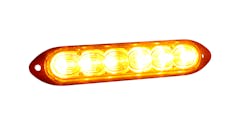The Federal Motor Carrier Safety Administration has granted Grote Industries LLC's application for a limited 5-year exemption to allow motor carriers operating trailers and van body trucks to install rear amber brake-activated pulsating warning lamps. The agency determined that granting the exemption would likely achieve a level of safety equivalent to or greater than the level of safety provided by the regulation, the standard by which exemptions are judged. This exemption is effective through Dec. 2, 2025.
The Grote filing, posted May 12, noted that the request was very similar to exemptions that already exist for other classes of commercial motor vehicle operators, including “operators of tanker trailers, school bus operators, tow truck operators, and operators of vehicles transporting oversized loads.”
Indeed, the Grote filing came just over a year after tank truck carrier Groendyke Transport Inc. was granted permission to install an amber brake-activated pulsating lamp on its tank trailers in addition to the steady-burning brake lamps required by the FMCSRs. Supporting its case, Groendyke in 2015 began testing an amber brake-activated pulsating lamp on some of its fleet without authorization from FMCSA.
Data gathered by Groendyke between January 2015 and July 2017 showed that trailers equipped with both the pulsating lamp and the steady-burning brake lamps were involved in 33.7% fewer rear-end collisions as compared to vehicles equipped with only the steady-burning brake lamps.
In its approval of the Groendyke 5-year limited exemption, FMCSA called the test results “both persuasive and compelling given the magnitude of the rear-end crash population.”
In the Grote request, the decision noted that both FMCSA and NHTSA have conducted extensive research and development programs to examine alternative rear-signaling systems to reduce the incidence of rear-end crashes. However, while these efforts concluded that improvements could be realized through rear-lighting systems that flash, neither the FMCSRs nor the Federal Motor Vehicle Safety Standards (FMVSS) currently permit the use of pulsating, brake-activated lamps on the rear of CMVs—thus an exemption is required.
FMCSA also acknowledged the concerns filed by the Transportation Safety Equipment Institute that the widespread use of amber brake-activated pulsating warning lamps may reduce the overall effectiveness of amber strobe lamps frequently used by emergency and service vehicles. However, the potential benefits were the determining factor.
The Commercial Vehicle Safety Alliance filed comments in support of the exemption.
Grote Industries welcomed the decision, noting that the company didn’t stop with just petitioning for the waiver. To bring greater visibility to trailers during the critical moments when the vehicle is braking, engineers at Grote developed a new Auxiliary Strobe and Stop Lamp, an add-on warning light that can be easily wired into a trailer’s existing brake light circuit.
The new light was designed to effectively draw the attention of traffic and give following motorists greater warning of braking. To ensure that nearby drivers are aware of the vehicle’s actions, braking initiates a sequence of five amber flashes in four seconds followed by a solid-red burn. This light sequence far exceeds the attention-getting capability of standard solid-burn brake lights while not overwhelming following drivers with long periods of strobing, according to Grote.
“The unique advantages of Grote’s Auxiliary Strobe and Stop Lamp have gotten the attention of fleets throughout the nation,” said Grote’s Director of National Fleet Sales Mark Blackford, who found uniformly strong interest in the new lamp. “Additional functionality for auxiliary lights will cut down on accidents and property damage and will make our roadways safer. With a product like this, at the end of the day, everyone wins.”






